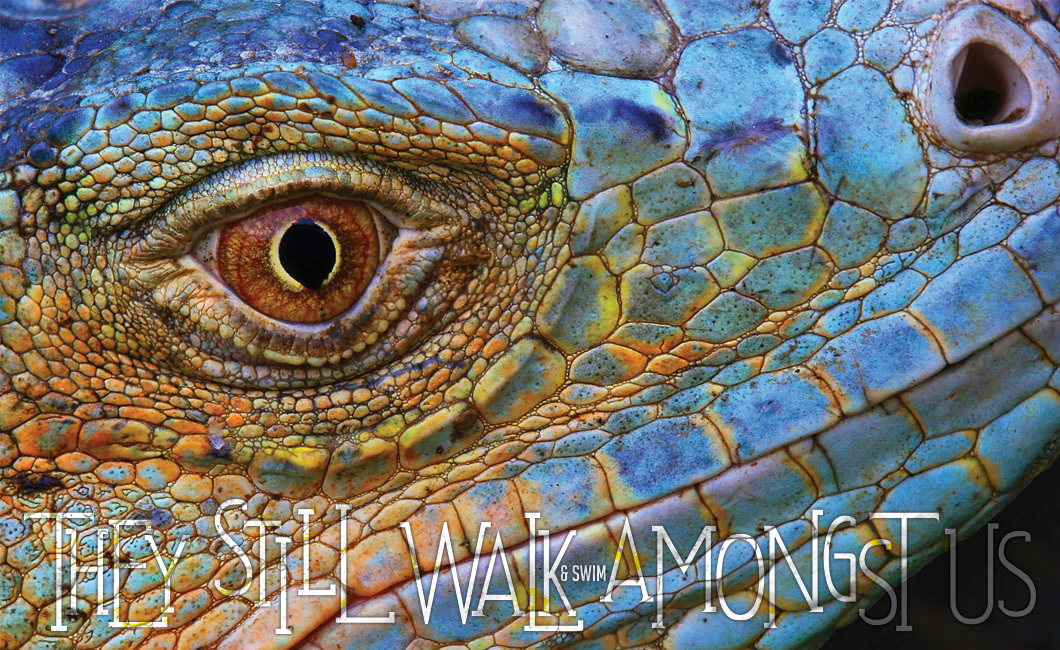- https://list25.com/25-prehistoric-animals-that-are-alive-today/
- http://www.dinodatabase.com/dinoage.asp
- https://www.britannica.com/science/Cryogenian-Period
- https://quoteinvestigator.com/2014/05/04/adapt/
- https://protecttheoceans.org/wordpress/?p=1591
- https://www.fws.gov/international/laws-treaties-agreements/us-conservation-laws/endangered-species-act.html
- https://www.huffingtonpost.com/entry/12-things-we-should-all-do-to-protect-endangered-species_us_58bd9c87e4b0abcb02ce2067
Written by Jenifer Chrisman on December 12, 2018.
It is not the most intellectual of the species that survives; it is not the strongest that survives; but the species that survives is the one that is able best to adapt and adjust to the changing environment in which it finds itself.
– Leon C. Megginson, on the Origin of Species
The sweeping ages of the dinosaurs, known as the Mesozoic Era (Triassic: 245-208 million years ago, Jurassic: 208-145 million years ago and Cretaceous: 145-66 million years ago), ended with an extinction-level event. But remnants remain, not just from the age of the dinosaurs, but millennia before. One such animal even saw the start of the Cryogenian Period (720-635 million years ago), when most of the Earth’s surface was covered in ice.
Not only have these species survived millions of years, there has been little to no change from their prehistoric behavior and appearance to now:
72-66 million years ago
16: Alligator Snapping Turtle
Scientific name: Macrochelys temminckii

Weighing in at up to 400 pounds and primarily found in the waters of the southeastern United States, alligator snapping turtles have a long fossil history dating back to the Maastrichtian stage (72-66 million years ago) in the Late Cretaceous period. They are the heaviest freshwater turtle worldwide.
76 million years ago
15: Solenodon (mammal)
Scientific name: Solenodon

Small, venomous, burrowing and nocturnal, Solendon, meaning "slotted tooth", are endemic to some of the Caribbean countries. Often called a living fossil, their primitive characteristics are in keeping with their prehistoric ancestors from 76 million years ago.
100 million years ago
14a: Alligator Gar (fish)
Scientific name: Atractosteus spatula
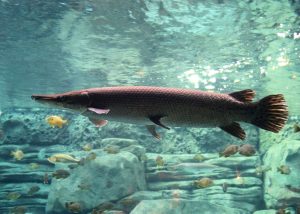
From their earliest ancestors (100 million years ago), the alligator gar retains its spiral valve, allowing it to breathe both in water and air. They are one of North America’s largest freshwater fish.
100 million years ago
14b: Giant Freshwater Stingray
Scientific name: Himantura chaophraya
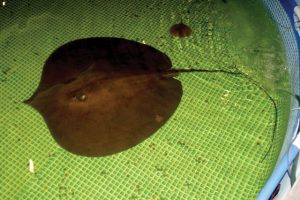
Growing upward of 6.2 feet across and reaching as much as 1,300 pounds, the giant freshwater stingray is one of the world’s largest fish. Its thin, oval pectoral fin disc evolved around 100 million years ago and, due to habitat degradation, display and fishing, it faces extinction.
120 million years ago
13: Martialis Heureka (ant)
Scientific name: Martialis heureka
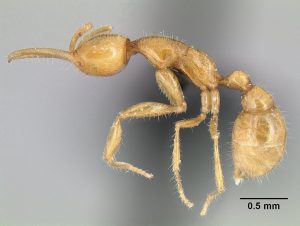
The martialis heureka’s ancestry is the oldest known, distinct ant lineage, dating back to approximately 120 million years ago. Discovered in Brazil’s Amazon rainforest in 2000, it has diverged from all other ant species, which is easily identifiable due to its unusual morphology.
125 million years ago
12: Goblin Shark
Scientific name: Mitsukurina owstoni
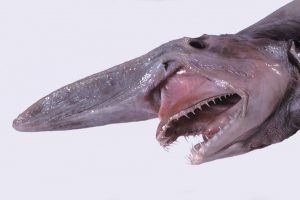
Rare and poorly understood, this bizarre looking shark can grow up to 13 feet long and can trace its ancestry back 125 million years. Despite its size and appearance, it is fairly harmless to humans.
150-95 million years ago
11: Frilled Shark
Scientific name: Chlamydoselachus anguineus
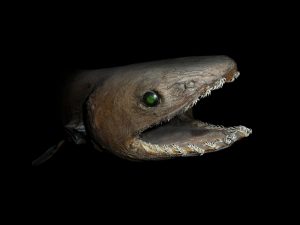
Its exact lineage unknown, possibly the Late Jurassic (150 million years ago), but definitely as far back as the Late Cretaceous (95 million years ago), the frilled shark is one of the oldest living shark species. With a frightening visage, they live at depths of 160-660 feet in both the Pacific and Atlantic Oceans.
170 million years ago
10: Chinese Giant Salamander
Scientific name: Andrias davidianus
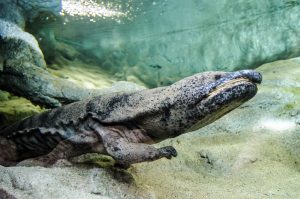
Reaching lengths of up to 5.9 feet, the Chinese giant salamander is the largest amphibian and salamander in the world. Due to over-collection, habitat loss and pollution, these salamanders, who can date their lineage back 170 million years, are critically endangered.
200 million years ago
9a: Sturgeon (fish)
Scientific name: Acipenseridae
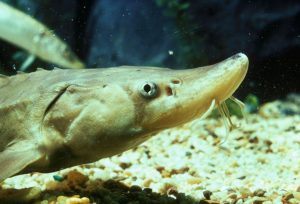
Nearly unchanged for around 200 million years, the sturgeon occupies rivers, lakes and coastlines that span the subtropical to the sub-Arctic. Like others on this list, due to habitat destruction, over-harvesting and pollution, they are not only critically endangered, some of their species are at the edge of extinction.
200 million years ago
9b: Tuatara (reptile)
Scientific name: Sphenodon
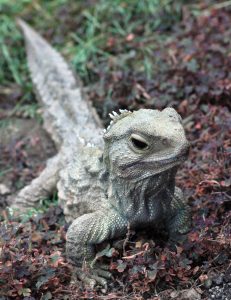
Especially pronounced in males, Tuatara have a spiny crest along their back and are endemic to New Zealand. They have remained nearly unchanged in over 200 million years, yet they look like modern-day lizards and reptiles.
220 million years ago
8: Tadpole Shrimp
Scientific name: Notostraca

These crustaceans resemble the horseshoe crab in miniature, but live in fresh water. After some 220 million years, the bodies of tadpole shrimp are an exact match to their ancient ancestors.
250 million years ago
7: Crocodilians
Scientific name: Crocodilia

First appearing in the Early Triassic (250 million years ago), and unlike many other "living fossils", crocodilians share a resemblance to the dinosaurs. The crocodilian family includes the alligator, caiman, crocodile, gharial and false gharial.
360 million years ago
6: Lamprey (eel)
Scientific name: Petromyzontiformes

Bearing a striking resemblance to the modern day lamprey, the oldest fossil found dates back 360 million years and was found in South Africa. Although known for boring into the flesh and sucking the blood of their prey with their jawless, funnel-like, toothed mouths, only a minority 38 known types of this species have been proven to do so.
400 million years ago
5: Coelacanth (fish)
Scientific name: Coelacanthiformes
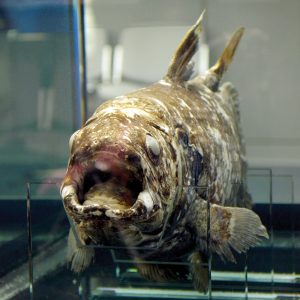
Rediscovered in 1938, Coelacanth reached their current evolutionary form approximately 400 million years ago. They are more closely related to lungfish, reptiles and mammals and are native to the Indonesian and Indian Ocean coastlines
450 million years ago
4: Horseshoe Crab
Scientific name: Limulidae
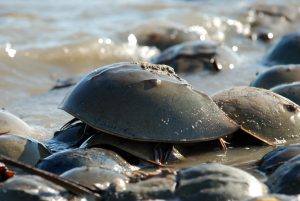
Virtually unchanged for around 450 million years, horseshoe crabs are considered the closest relative to the trilobite. They live on soft sandy or muddy bottoms in and around shallow ocean waters.
500 million years ago
3: Nautilus
Scientific name: Nautilidae
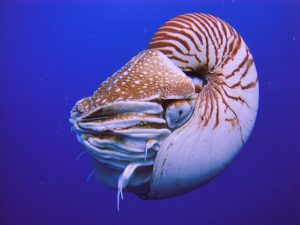
Surviving great planetary changes and several mass extinctions, the nautilus’ fossil record dates back 500 million years. Severely endangered, they inhabit the western and central Pacific Ocean and the Indian Ocean.
700 million years ago
2: Jellyfish
Scientific name: Medusozoa
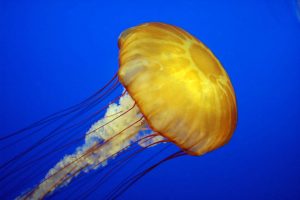
Found across the surface or in the watery depths, jellyfish can be found across the world’s oceans. They are the oldest multi-organ animal, dating back 700 million years, and appear to be expanding their populations due to overfishing of their natural predators. However, some are endangered.
760 million years ago
1: Sponge
Scientific name: Porifera
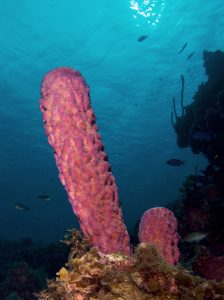
Although an exact estimate has been difficult, the fossil of a sea sponge proves they have been around for at least 760 million years. From fresh water to salt water, there are over 5,000 species worldwide and, despite common misconception, they are an animal, not a plant.
Most of these animals, whose ancestors date back millions of years, are on the endangered species lists. The Endangered Species Act of 1973 aims to protect and conserve, not only these and other animals like them, but their habitats as well. If something isn’t done soon, the only thing left of them will be museum displays or photos. If you or someone you know wants to help, the Huffington Post offers "12 Things We Should All Do To Protect Endangered Species," by Susie Almaneih, Contributor. For details, visit: https://www.huffingtonpost.com/entry/12-things-we-should-all-do-to-protect-endangered-species_us_58bd9c87e4b0abcb02ce2067.
Sources:



